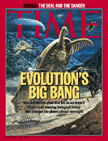 Time Magazine, Letter to the Editor (unpublished), by Dr. Senapathy in response to the December 4, 1995 cover story about the Cambrian explosion, "Evolution's Big Bang."
Time Magazine, Letter to the Editor (unpublished), by Dr. Senapathy in response to the December 4, 1995 cover story about the Cambrian explosion, "Evolution's Big Bang."
 Time Magazine, Letter to the Editor (unpublished), by Dr. Senapathy in response to the December 4, 1995 cover story about the Cambrian explosion, "Evolution's Big Bang."
Time Magazine, Letter to the Editor (unpublished), by Dr. Senapathy in response to the December 4, 1995 cover story about the Cambrian explosion, "Evolution's Big Bang."
Time: "For billions of years, life on earth was dominated by plankton, bacteria and algae. Then, in a burst of creativity like nothing before or since, nature sketched the designs for virtually the entire animal kingdom. What could have powered biology's "Big Bang"? [Full story text]
J. Madeleine Nash beautifully describes the details of the Cambrian explosion. She brought out some major shortcomings of the theory of evolution which cannot explain the fundamental Cambrian explosion issue: How can the evolution of numerous complex organisms occur in a geological instant from a common ancestor?
Not surprisingly, almost all the scientists whom Nash interviewed are paleontologists. With due respect to the paleontologists, the kind of answers that they provide -- such as the empty barrel hypothesis -- are all conjectural and have no relevance to the science at the molecular biological level. They only speak about the deployment of fossils in time and space. In the context of the origin of organisms, a molecular and genetic explanation is needed. But, molecular geneticists find it impossible to explain it in molecular terms. No one can explain the scenario of the Cambrian explosion in molecular or genetic terms using the theme of descent with modification.
I offer a more plausible scientific explanation of the same empirical findings of the Cambrian explosion. I have recently proposed a new theory on the origins of life, based on 14 years of molecular biology research into the origins of genes (Independent Birth of Organisms, Genome Press, 1994). Organisms have not descended from a common ancestor, but rather from millions of independently born organisms, whose genomes were all assembled from a common gene-pool from a single small primordial pond by using common biochemicals, genes, and molecular biological mechanisms. My computer studies of the split-genes of animals and plants show that such genes would have been easy to find in random sequences of primordial DNA. The similarities we see today are the result of the reuse of genes of previously made, viable organisms, and these similarities produce "false" evolutionary trees. Short-term adaptations and artificial selection do result in variations and even some new species, but those evolutionary mechanisms have not been responsible for the wide diversity of life and the many unique genes now being discovered in organisms.
This theme easily explains the origin of complex organisms directly from a primordial pond in a geological instant. Many scientific findings of molecular biology fully support and corroborate this new theory, such as the presence of both the very same genes and totally unrelated unique genes among many distinct organisms that are also anatomically unrelated. It is also consistent with the well known zoological findings that the body plans and anatomical structures of the numerous distinct creatures (the so called 'higher-taxa") are actually unrelatable.
The distinctness and the variety of Burgess Shale fauna cause puzzlement to paleontologists and biologists. But this scenario fits with my theory, too, which says that life is highly probable in many primordial ponds on earth (and on any planet in the universe with similar, conducive primordial conditions), and that multiple organisms could spawn from a common pool of genes in each pond. So, the Cambrian, Ediacaran, Tommotian, and the Burgess organisms were all the products of different ponds. There was an explosion of unique creatures at a geological instant in the life-crops from each pond.
Periannan Senapathy, Ph.D.
Madison, WI